An inexpensive place to camp along an unusual environment and take in a little birding at the Salton Sea turned into three days of changing light and colors.
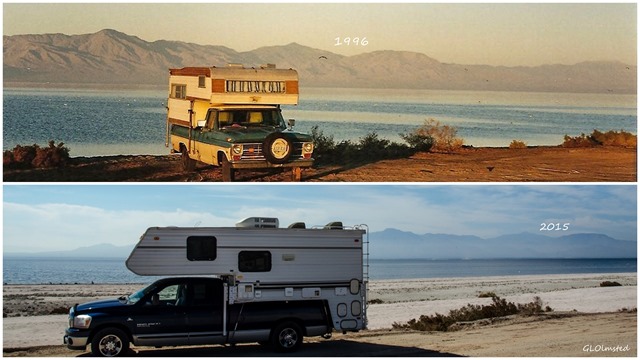 Note the matching mountain horizon
Note the matching mountain horizon
After chasing for wildflowers and hiking a slot canyon it was time to move on from Anza-Borrego. I drove in a U from the west, around the north end of one of the worlds largest inland seas, to the eastern side where the Salton Sea State Recreation Area spans 14 miles of shoreline. Stopped at the first and northern most camp but didn’t like the idea of paying $20 to dry camp in a parking lot or $30 in the same lot with hookups and a couple trees. The visitor center wasn’t open so down the road I went and the next option wasn’t any better. Almost 20 years ago I camped along the sea close to the shore and was thinking that area may have been developed so thought about bagging it completely but then continued south another couple miles on CA111 to the next option.
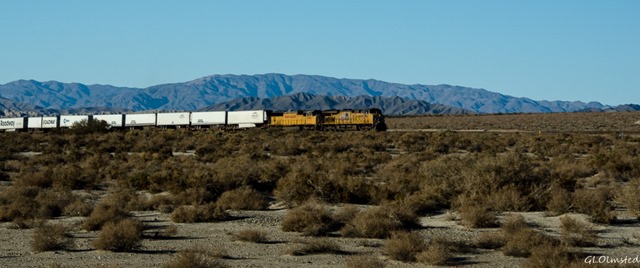 Corvina Beach is $10/night, less if you’re a senior over 62 which I’m not quite, and it offers toilets, cold showers and parking along a strip of gravel road overlooking the sea with the Santa Maria Mountains across the way. It was WINDY when I pulled in which I expected because the entire drive from Anza-Borrego had been a knuckler as gusts tried to push me off the road. The down side of this camp is being within a couple hundred yards of the highway, which thank goodness doesn’t have too much night traffic, and a paralleling rail line with trains running pretty regularly. Plus it’s a single track with a nearby siding where one train waits for the other then has to rev up the engine to get moving again. But all worth it for the birds.
Corvina Beach is $10/night, less if you’re a senior over 62 which I’m not quite, and it offers toilets, cold showers and parking along a strip of gravel road overlooking the sea with the Santa Maria Mountains across the way. It was WINDY when I pulled in which I expected because the entire drive from Anza-Borrego had been a knuckler as gusts tried to push me off the road. The down side of this camp is being within a couple hundred yards of the highway, which thank goodness doesn’t have too much night traffic, and a paralleling rail line with trains running pretty regularly. Plus it’s a single track with a nearby siding where one train waits for the other then has to rev up the engine to get moving again. But all worth it for the birds.
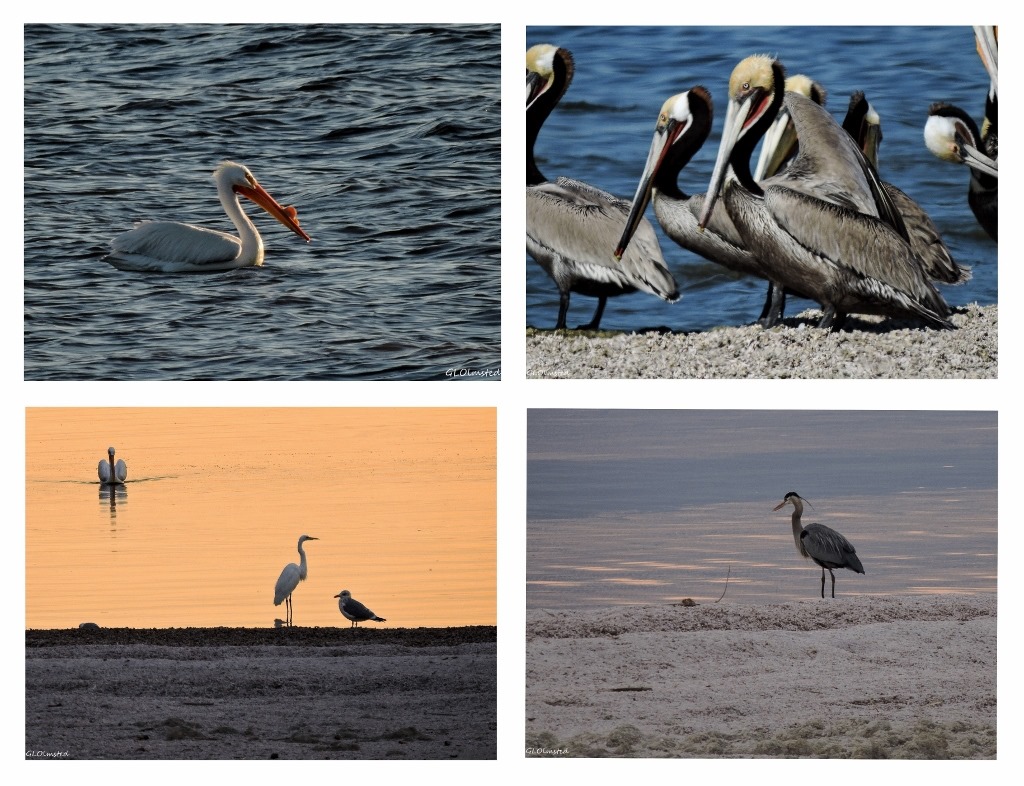 White pelican, Brown pelicans, Great blue heron, & Great egret with White pelican & Gull (don’t know which one)
White pelican, Brown pelicans, Great blue heron, & Great egret with White pelican & Gull (don’t know which one)
As soon as I was level I jumped inside to get out of the wind and immediately began bird watching, through the window. American White Pelicans displayed their breeding horns and Brown Pelicans their colors, white, blue and green herons, lots of Seagulls and even some Grebes. The smaller of my cameras has 60x zoom which I can’t possibly hold still enough to use. Eventually I broke down and got the tripod out but then discover it’s not easy to take bird photos from a stationary position. Then add the bouncing and bobbing on rough wind blown waters.
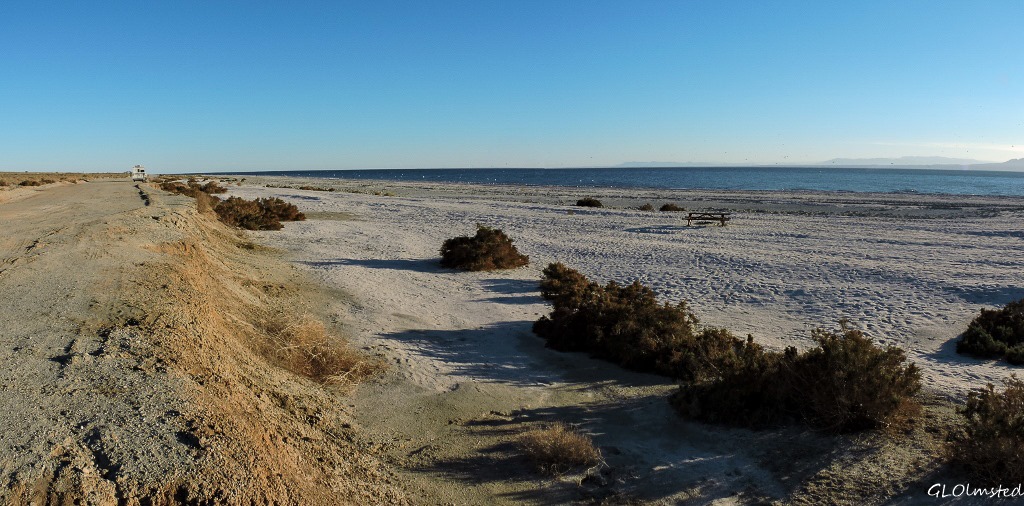 The next morning the water was almost as smooth as glass. I at first thought to stay only one night but became intrigued enough I stayed for three. So I walked down the road to the Iron Ranger to pay and then came back on the beach. If you can call this a beach. It’s a blinding white color of exo and not so exoskeletons of whatever is living and dying in the sea. It’s like walking on very course sand with a crunching sound as if stepping on broken fine china.
The next morning the water was almost as smooth as glass. I at first thought to stay only one night but became intrigued enough I stayed for three. So I walked down the road to the Iron Ranger to pay and then came back on the beach. If you can call this a beach. It’s a blinding white color of exo and not so exoskeletons of whatever is living and dying in the sea. It’s like walking on very course sand with a crunching sound as if stepping on broken fine china.
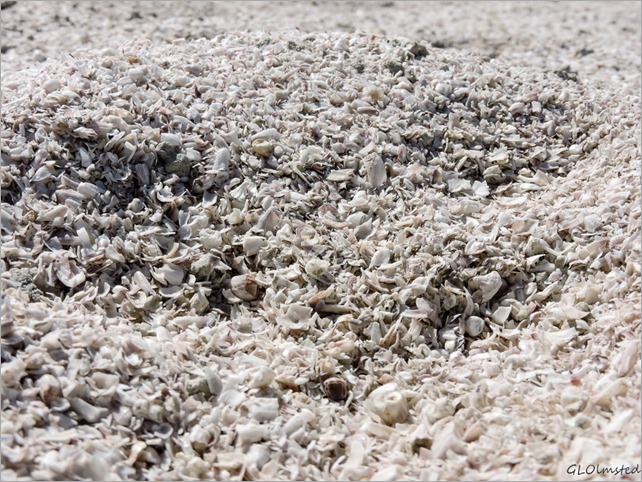 Wave-cut shorelines along the hillsides indicate this basin has been occupied by both fresh and salt water lakes in the geologic past. Yet the current sea was created by accident when the Colorado River breached a levee along an irrigation canal flooding into the dry lake bed, for two years before engineers stopped the flow in 1907 and washed out a portion of railroad line between Los Angels and Tucson. The end result was a 45 by 20 mile body of water which became a recreational haven for boating and fishing during the 1950s when the sea was stocked with fish from the Gulf of California. Yet with no natural outlet, or inlet except for agricultural chemical runoff, the sea soon exceeded ocean salinity causing the die-off of fresh water species. Within 20 years boom towns became ghost towns. The “beach”, made up the crushed bones of dead fish, become odorous and unpleasant in the high heat of summer.
Wave-cut shorelines along the hillsides indicate this basin has been occupied by both fresh and salt water lakes in the geologic past. Yet the current sea was created by accident when the Colorado River breached a levee along an irrigation canal flooding into the dry lake bed, for two years before engineers stopped the flow in 1907 and washed out a portion of railroad line between Los Angels and Tucson. The end result was a 45 by 20 mile body of water which became a recreational haven for boating and fishing during the 1950s when the sea was stocked with fish from the Gulf of California. Yet with no natural outlet, or inlet except for agricultural chemical runoff, the sea soon exceeded ocean salinity causing the die-off of fresh water species. Within 20 years boom towns became ghost towns. The “beach”, made up the crushed bones of dead fish, become odorous and unpleasant in the high heat of summer.
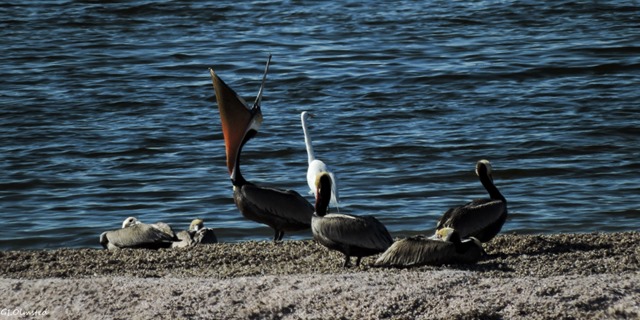 However, the sea has been called a “crown jewel of avian biodiversity” located along a major flyway with over 400 documented resident and migratory bird species and supports a large population of American White Pelicans. And I saw hundreds of them along with Brown Pelicans which the host told me are usually gone from the area by the end of November.
However, the sea has been called a “crown jewel of avian biodiversity” located along a major flyway with over 400 documented resident and migratory bird species and supports a large population of American White Pelicans. And I saw hundreds of them along with Brown Pelicans which the host told me are usually gone from the area by the end of November.
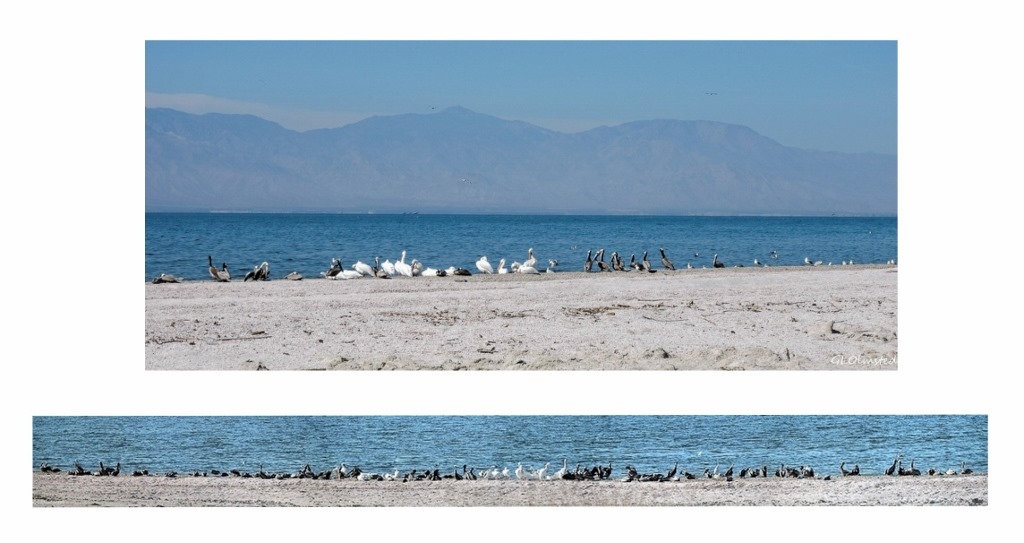 During mid-day lines of brown and white pelicans lounged at the water’s edge along with some seagulls. Although the brown and white groups clustered together I found it interesting that they hung out next to each other. In the gap between beached groups a couple of white pelicans would float along interspersed with gulls and obviously fishing. In fact when a gull would dive into the water every bird within 20 feet descended for a hopeful piece of the catch. Seagulls are such a competitive group flapping and yacking at each other like a democrat and republican locked in a closet together.
During mid-day lines of brown and white pelicans lounged at the water’s edge along with some seagulls. Although the brown and white groups clustered together I found it interesting that they hung out next to each other. In the gap between beached groups a couple of white pelicans would float along interspersed with gulls and obviously fishing. In fact when a gull would dive into the water every bird within 20 feet descended for a hopeful piece of the catch. Seagulls are such a competitive group flapping and yacking at each other like a democrat and republican locked in a closet together.
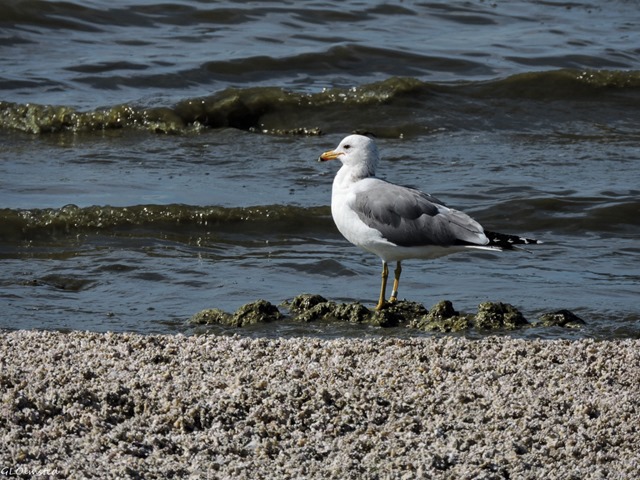 Bird watching is kind of like people watching only better. (If anyone knows what kind of gull this is please speak up.)
Bird watching is kind of like people watching only better. (If anyone knows what kind of gull this is please speak up.)
The following day I again walked the beach but worked my way closer to the water while still allowing enough space so as not to disturb the birds. As I get closer to the water scattered fish carcasses, picked clean and breaking apart, create the crunchy beach, and it stinks. Not pass-out-foul stink, but certainly an unpleasant odor. I picked up my pace a little bit to get closer to the water but that didn’t help. So I returned to the short bluff and found a picnic table to sit on. Farther away was no smell and the small distance obscured the bone-yard beach.
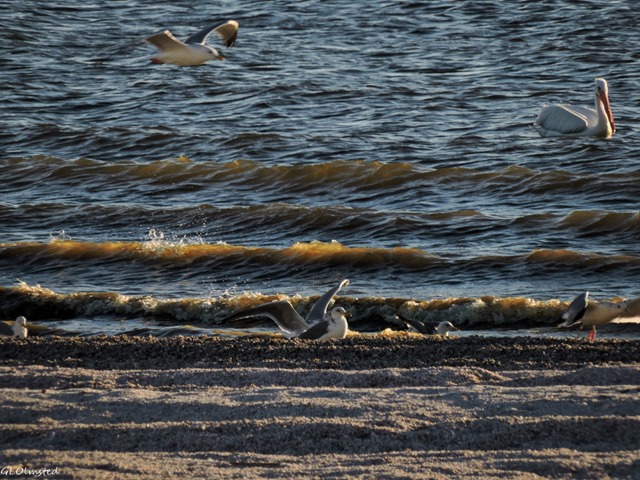 The camp host said the sea is dropping at an alarming rate of two feet per year. What first appeared as a sea of deep blue became muddy green at closer inspection. And though the water level is dropping the salinity is rising. Agricultural drainage flowing into the sea contains selenium, salts, and pesticides that threaten all the life in the sea from worms in the bottom, to fish and birds with increased levels working up the food chain. Selenium poisoning could have been the cause of 150,000 eared grebes to die at the sea in 1992. I certainly wouldn’t eat any of the fish from here.
The camp host said the sea is dropping at an alarming rate of two feet per year. What first appeared as a sea of deep blue became muddy green at closer inspection. And though the water level is dropping the salinity is rising. Agricultural drainage flowing into the sea contains selenium, salts, and pesticides that threaten all the life in the sea from worms in the bottom, to fish and birds with increased levels working up the food chain. Selenium poisoning could have been the cause of 150,000 eared grebes to die at the sea in 1992. I certainly wouldn’t eat any of the fish from here.
The Sonny Bono Salton Sea National Wildlife Refuge is located at the southern end of the Salton Sea in California’s Imperial Valley. I didn’t visit there but have heard it is notable for birding. Currently the Salton Sea Ecosystem Restoration Program is working on a plan to “to provide a range of aquatic habitats that will support fish and wildlife species dependent on the Salton Sea.” Several solutions have been suggested including the creation of an artificial outlet, diking off sections to keep the remaining less saline, and evaporation ponds to create solar energy.
 I hope the sea can be rescued and continue to provide habitat for all the birds which I thoroughly enjoyed watching. Yet I equally enjoyed watching the changing pallet of light and colors throughout the day. Pre-dawn looks like winter whites and the day starts off with soft pastels and a gentle glow on both sea and sky. When the sun rises golden rays light up the Santa Maria Mountains followed by a soft wash over the entire scene.
I hope the sea can be rescued and continue to provide habitat for all the birds which I thoroughly enjoyed watching. Yet I equally enjoyed watching the changing pallet of light and colors throughout the day. Pre-dawn looks like winter whites and the day starts off with soft pastels and a gentle glow on both sea and sky. When the sun rises golden rays light up the Santa Maria Mountains followed by a soft wash over the entire scene.
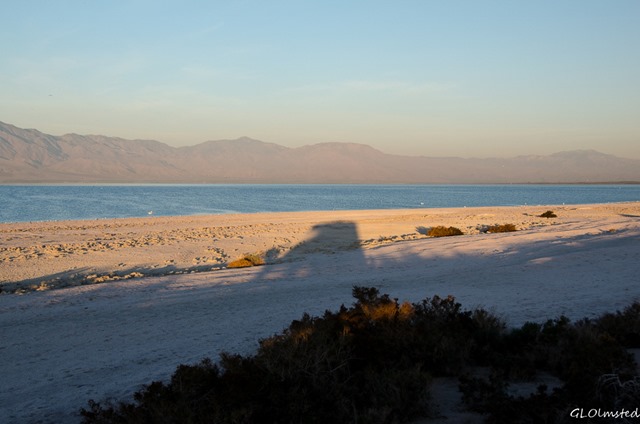 Then the shore turns to pink, a soft peach, a pale grapefruit and as the sun rises higher the beach becomes a pale lemon yellow.
Then the shore turns to pink, a soft peach, a pale grapefruit and as the sun rises higher the beach becomes a pale lemon yellow.
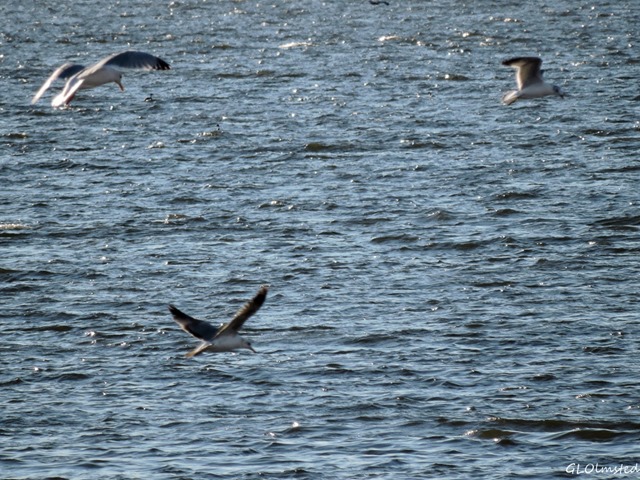 And suddenly the shore bound birds take flight.
And suddenly the shore bound birds take flight.
 At high noon the light is squinty bright like a crisp Caribbean day.
At high noon the light is squinty bright like a crisp Caribbean day.
 And sunset brings a blaze of color turning the sea into liquid gold.
And sunset brings a blaze of color turning the sea into liquid gold.

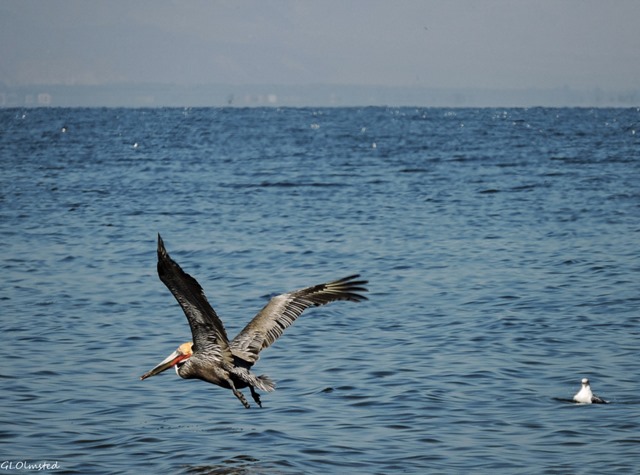


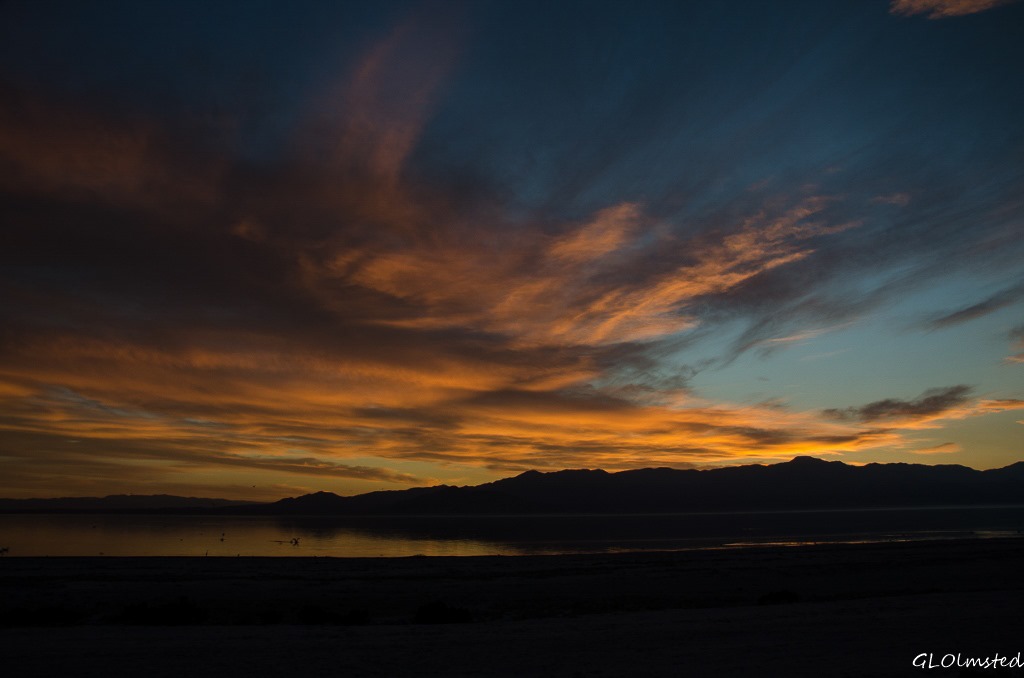
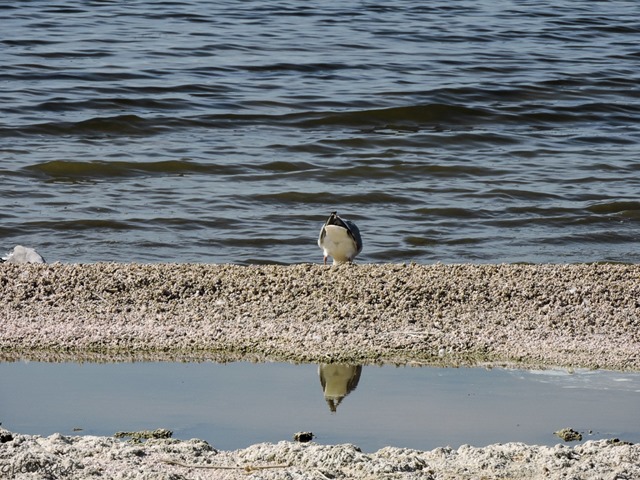
.jpg)
